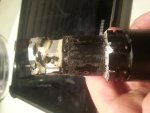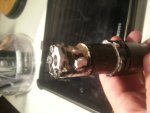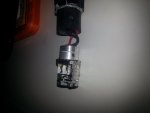OK, just place the fluke meter set to measure voltage with the proper range for what you expect to measure, or if it can just be set to auto-range, that will work fine too. Place the leads of the volt meter across the input wires or contacts to the driver and see if there is voltage there. If you can't measure voltage to the input wires of the driver due to everything being torn apart, I guess you will have to find a way to hook up some wires leading from your battery pack, or some external DC power supply set to the correct input voltage/what the batteries produced. Make sure you use the correct polarity if powering it from an external source! If you use an external DC power supply which is plugged into AC power/the wall, turn it on, set the voltage & current limit to zero and then hook up the wires to the diode last, after that set the current limit to where it should be and slowly turn the voltage up to the proper voltage, or what the batteries would produce. When you first turn them on, many DC power supplies will spike a short duration high voltage output which will quickly destroy a laser diode. Turn the voltage all the way down and disconnect the wires to the laser before turning off too.
Once you have power to the driver section, there should be some wires coming out of it which feed the laser diode, maybe you can't see them because they are buried in the head all glued together. If you can get at them, you could measure the voltage between the case of the laser and the wire or wires going into the laser diode to know if the driver is producing voltage or not.
I think it is a good idea to test the driver before tearing into the optics, if it isn't producing output voltage, no reason to dig further. As far as measuring the current output of the driver, this might be hard to do with the short wires leading from it to the laser diode and probably unnecessary, if there is voltage there that says something. If the lead or leads going to the laser diode are long enough, you could break one of the wires, the negative wire, and insert the fluke meter in series with that wire to measure current. The meter would need to be set to the expected current range or on auto-range as well as the leads of the meter placed in the proper holes to measure current, or A. When done, plug those leads back into the V and common lead holes or you will blow the internal fuse the next time you try to measure voltage.
For 532nm DPSS lasers, the case is usually positive and can be used to place the negative lead of your volt meter for that half of the power input, if the batteries are in the tube, the meter will then show a negative voltage when you place the plus or red lead of the meter on the negative lead going to the laser diode. If the battery tube is removed, you can normally find the positive ground for the meters test lead on the lasers head. It doesn't really matter which lead you use to measure the voltages, red or black can be on the lasers body and use the other color to measure the negative lead going to the laser diode, your meter will work either way, just that it will show a negative sign if the lead polarities are reversed.
All of this might be a waste because I doubt you will find a problem there, but you should check the driver first. Unless you want to use this as a learning experience with the risk of making things worse, I'd send this laser to someone who has experience with them.
You might try this, hook everything back up normal and point the laser into a cheap video camera, or phone camera and see if there is any kind of glow coming from the end of the lasers output, even if faint on the camera, that would indicate the laser diode is producing some infrared power but something to do with the KTP crystal or alignment is messed up. Although I believe this type of laser has an IR filter, so it might block it anyway. Don't look into the laser output, even if no green output! Infrared could be present! The reason for using the camera is because your eyes can't see 1064nm infrared but some digital cameras can pick it up.
For those interested in finding a cheap used infrared camera, you can find an Olympus Camedia C-2000 on ebay for cheap these days which shows IR as a white light, only thing is it must include the digital memory stick it uses with it or the camera won't work, as well as the data cable to offload it to your computer as most computers can't read that old type of memory due to its wide physical size.







